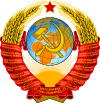Emblem of the Transcaucasian Socialist Federative Soviet Republic
| Emblem of the Transcaucasian Socialist Federative Soviet Republic | |
|---|---|
 | |
| Armiger | |
| Adopted | 1923 |
| Blazon | Baroque shield with hammer and sickle |
| Other elements | Red star, rising sun, Caucasus mountains backdrop, factory, oil drilling rigs, wheat, cotton, maize, rice, grapes |
| Earlier version(s) |    |
This article does not cite any sources. (September 2018) |
The Emblem of the Transcaucasian SFSR was adopted by the government of the Transcaucasian SFSR. The final version was adopted in 1930.
The emblem is based loosely on the state emblem of the Soviet Union. It incorporates designs from each of the three major groups that combined in the Transcaucasian SFSR, the Armenians, Azeri and Georgians, and unusually features Islamic art and communist elements side by side. The latticework in the star itself bespeaks the former coat of arms of Georgia from 1918-1921 and adopted again from 1991-2004; the crescent represents the Muslim Azeris, on a background depicting the national symbol of the Armenians, Mount Ararat. The rising sun stands for the future, the star as well as the hammer and sickle for the victory of communism and the "world-wide socialist community of states".
In 1936, the republic was dissolved and the three regions became the Georgian, Armenian, and Azerbaijan SSR respectively.
See also[]
- Caucasus stubs
- Heraldry stubs
- Coats of arms of the Soviet Union
- Coats of arms with wheat
- Coats of arms with stars
- Coats of arms with suns
- Coats of arms with sunrays
- Coats of arms with mountains
- Coats of arms with buildings
- Coats of arms with maize
- Coats of arms with rice
- Coats of arms with grapes
- Coats of arms with cotton
- Transcaucasian Socialist Federative Soviet Republic
- Symbols introduced in 1923
- Symbols introduced in 1930
- Mount Ararat

